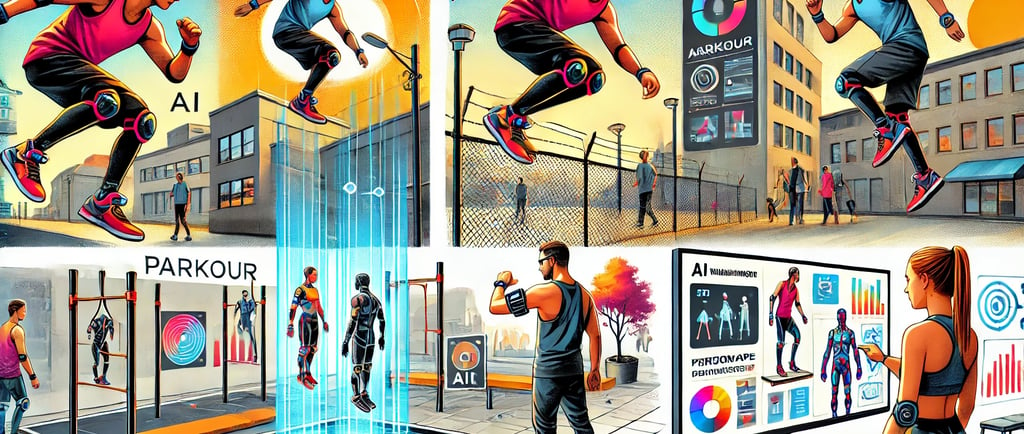AI and Parkour: How AI Could Create Safe Virtual Parkour Challenges
7/3/20244 min read


Introduction to AI in Parkour
Parkour, a discipline that involves navigating through complex environments using running, jumping, climbing, and other movements, has gained significant popularity over the years. This physical discipline emphasizes efficiency, agility, and the ability to overcome obstacles, making it both a challenging and exhilarating activity. However, the inherent risks associated with parkour can sometimes overshadow its benefits, particularly for beginners or those attempting advanced maneuvers.
Artificial intelligence (AI) is now being integrated into the world of parkour to mitigate these risks and enhance the overall experience. AI technologies can create virtual environments that simulate real-world challenges, allowing practitioners to practice and refine their skills in a controlled setting. These virtual parkour challenges can be specifically tailored to individual skill levels, making the sport more accessible and safer for everyone.
The application of AI in parkour isn't just about safety; it also opens up new avenues for creativity and innovation. By leveraging AI, developers can design intricate and dynamic virtual courses that would be impossible to replicate in the physical world. These digital environments can be adjusted in real-time, providing instant feedback and adaptive challenges that evolve with the user's progress. This not only enhances the learning curve but also keeps the experience engaging and stimulating.
Safety remains a paramount concern in parkour, and AI is instrumental in addressing this issue. Virtual challenges eliminate the physical risks associated with high-impact movements and hazardous environments. Users can practice complex sequences and high-risk maneuvers without the fear of injury, thanks to the safe confines of a virtual setting. This approach not only preserves the thrill and essence of parkour but also ensures that practitioners can push their limits without compromising their well-being.
As we delve further into the integration of AI in parkour, it becomes evident that this technology holds immense potential to revolutionize the sport. By creating safe and dynamic virtual challenges, AI can make parkour more accessible, inclusive, and enjoyable for enthusiasts of all levels.
Technological Framework: AI Algorithms and Virtual Environments
The intersection of AI and parkour presents an intriguing technological landscape. At the core of creating safe virtual parkour challenges are advanced AI algorithms capable of simulating realistic physical dynamics and environmental interactions. These algorithms often rely on physics-based models to replicate the intricate movements and forces experienced during parkour. By integrating these models, AI can generate virtual environments that closely mimic real-world scenarios, providing users with an immersive experience.
Machine learning plays a pivotal role in enhancing these virtual parkour challenges. Through the analysis of user movement data, machine learning algorithms can predict and adapt to individual performance levels. This adaptability ensures that the virtual challenges are personalized, dynamically adjusting the difficulty and complexity based on the user's skills and progress. Reinforcement learning, a subset of machine learning, is particularly useful in this context. It allows AI to learn from user interactions, continuously refining the virtual parkour environment to optimize safety and engagement.
The technological framework also encompasses various software and hardware components essential for creating these virtual experiences. Virtual Reality (VR) headsets provide users with an immersive visual and auditory experience, making the virtual parkour challenges feel incredibly lifelike. Motion sensors and tracking devices capture precise user movements, feeding data back to the AI algorithms for real-time analysis and adaptation. These sensors ensure that the virtual environment responds accurately to the user's actions, maintaining the illusion of a seamless, physical space.
Furthermore, advanced graphics engines and simulation software are employed to render the virtual environments with high fidelity. These tools are crucial for creating visually rich and interactive settings that enhance user immersion. By combining these technological elements, AI not only creates safe virtual parkour challenges but also pushes the boundaries of what is possible in the realm of digital sports and physical training.
Safety and User Experience in AI-Generated Parkour
In the realm of AI-generated virtual parkour, safety and user experience are paramount. Advanced artificial intelligence systems are designed to continuously monitor and evaluate a user's performance, providing real-time feedback that ensures both safety and improvement. These systems utilize a variety of sensors and algorithms to track a user's movements, identifying any potential risks and offering corrective guidance to prevent injuries. This dynamic feedback loop is essential for maintaining a safe environment while allowing users to push their limits.
One of the key advantages of AI in virtual parkour is its ability to create a balanced experience that is both challenging and safe. By analyzing a user's skill level and progression, AI can dynamically adjust the difficulty of parkour challenges. This adaptive approach ensures that users are continually engaged without being exposed to undue risk. The balance between challenge and safety is crucial, as it prevents the frustration and potential for injury that can arise from overly difficult tasks, while still providing a stimulating experience.
User testimonials and case studies offer valuable insights into the practical benefits of AI-generated parkour challenges. Many users have reported enhanced performance and reduced injury rates due to the personalized feedback and adaptive difficulty levels provided by AI. For instance, one user noted that the real-time adjustments made by the AI allowed them to improve their technique more rapidly than traditional training methods. Another case study highlighted a significant decrease in injury incidents, attributing this to the AI's ability to predict and mitigate risky movements.
While the integration of AI in virtual parkour has shown promising results, there are still areas for improvement. Some users have expressed the need for more intuitive interfaces and more diverse challenge scenarios to keep the experience fresh and engaging. As technology continues to evolve, these enhancements will likely be addressed, further solidifying the role of AI in creating safe and exciting parkour experiences.
